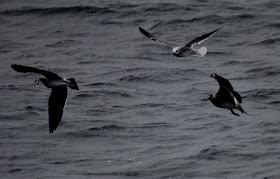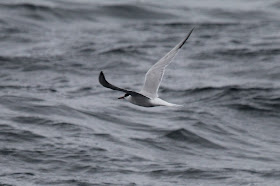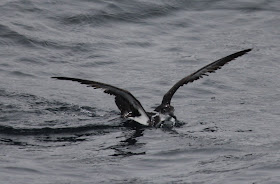The numbers of Manx Shearwaters also increased, often their numbers were scattered all over the water near the feeding whales-
Laughing Gulls and a Manx Shearwater-
Two Manx Shearwaters-
The Humpback "bubbling show" around the boat was amazing! (If you don't know what "bubbling" or "bubble-net feeding" is) Humpback whales employ an ingenious strategy to feed on schools of fish. The Whales begin calling to each other while circling the schools of fish. Their calls intensify becoming gradually higher in pitch and louder while circling the fish. They gather together beneath the catch, and blow air to create the bubble net (as shown in the images)....... (notice the Manx Shearwater taking advantage of the "bubble net")......
.....the Whales then swim the surface with their mouths wide open. They suddenly burst out of the water filling their open mouths with fish. After taking food and water into their mouths, humpbacks strain or filter the water through their baleen plates, trapping the ball of fish in their mouths.
Three Manx Shearwaters-
Excellent close-ups of flying Manx Shearwaters-
Another Parasitic Jaeger forces a Common Tern to give up its fish. The fish fell to the water, and the sharp-eyed Jaeger follows it down-
A first summer Laughing Gull has also seen the dropped fish, and moves in on the Jaeger.....
.....and successfully steals the fish right out from under the Jaeger!-
A striking Parasitic Jaeger!-
Another Jaeger appears; a gorgeous dark morph bird......
.......what a stunning bird!!
A few Greater Shearwaters were attracted to the feeding Whales-
Mika Ohtonen keeping watch with us on the pulpit, spots a Pomarine Jaeger (the second one sighted that day) in the distance.....
......which was a typical Pomarine; very large and heavy bodied bird with a powerful "Gull-like" flight. The dark morphed Jaeger flew east along the coast, nice find Mika!-
Third year Gannet-
More Manx Shearwaters-
Unusual mottled Humpback dorsal fin-
One of the hundreds of Common Terns-
Heavy-headed Cory's Shearwater-
Another Parasitic Jaeger and Cory's Shearwater-
Another beautiful Cory's leading the Dolphin X ahead of the pulpit-
A nice gift, a Sooty Shearwater (the first of three)-
More Cory's-
A pair of Parasitic Jaegers gang up on a Common Tern-
Two more Jaegers pass through a Gannet flock-
More Humpback pods feeding on the surface which attracted numbers of hungry Laughing Gulls and Manx Shearwaters-
Three Manx Shearwaters feed alongside surfacing Humpback (good study of size proportion)-
There are thirteen Manx Shearwaters in this image (Wow)!-
Laughing Gulls and Manx Shearwaters-
Naturalist John Conlon calls out the incredible whale and bird feeding frenzy just off the port side of the Dolphin X-
This pod of Humpbacks was giving us a great show "bubbling" and "blowing" while Laughing Gulls and Manx Shearwaters feast on the chaos of escaping herring-
Manx Shearwaters-
I like this shot; I am going to carve a Manx Shearwater decoy in this pose-
I like this image also.....
.....and this one also!-
Good size comparison between this open wing Manx and the tail fluke of this Humpback-
One of the few small flocks of White-winged Scoters-
Second, third and fourth year Gannets-
This Gannet let us get very close-
Second year Gannet with a fish in its bill-
One of the many flocks of Double-crested Cormorants-
As we were heading back to Provincetown Harbor, this beautiful Cory's Shearwater was flying just below the pulpit like Dolphins often do along the bulbous bow of the vessel. The images are not cropped to show just how close the bird was-
I cropped these images slightly to highlight the moulting feathers. (Notice the newly renewed darker tertials)-
Mid moult with some renewed primaries and secondaries, and greater secondary coverts-
The tail is still undergoing major moult (the tail rectrices are just begining to renew)-
The Cory's skims over the top of a wave-
Another Parasitic Jaeger flies by the vessel passing a crossing Gannet-
First year Gannet-
Wood End Lighthouse.....
......and more Jaegers-
As the Dolphin X pulled into its slip, everyone was busy commenting about the fantastic seabird and whale show we all had just experienced. We said good-bye to John and Capt. George and Thanked them for an amazing trip. It was by-far the best birding whale watch trip that Jen and I have been on with the Dolphin Fleet thanks to Capt. George and John Conlon. To see the complete GPS trip chart, see Tom's chart below on the bottom of this page-
Tom assembled everyone at a local restaurant for a quick lunch, and he checked out a few other locations such as Marconi Beach, Head of the Meadow Beach and a few others. Scoping these areas revealed many of the same species we had seen that morning, so we ended the day at First Encounter Beach. It was low tide, perfect for Shorebirding. A few Forster's Terns were feeding at the edges of the shallows along the sand bar, and there was a sizable Gull roost on the sand bars at the mouth of Herring Brook Marsh to the west. On this sandbar were sixty-five Laughing Gulls, eleven Common Terns and a few Herring and Greater Black-backed Gulls.
There were small groups of Shorebirds along the beach; Semi-palmated Plovers-
Dunlins-
Sanderlings-
Black-bellied Plovers-
and Greater Yellowlegs-
The last birds of the day; a flock of Double-crested Cormorants flying east along the dunes-
Guy Tudor reminiscing about the early days on the Cape. It was a great pleasure to meet you Guy!-
Parting shot, Head of the Meadow looking E/SE along the coast!- It was a wonderfully successful trip, Thanks to Tom Robben for putting it all together! Thank You Tom, Jen and I really enjoyed it!!
The next day on Sunday morning, Jen and I arranged and privately chartered a boat from Provincetown Harbor for a morning of seabirding from Long Point to Race Point Beach. There were five of us onboard and we had a great time, and oh yeah, there were birds too! To read about this trip,
"Want Seabirds- Just Add Chum" continues on the next page. Just click on "Older Posts" below right at the bottom of this report.
Tom's GPS trip chart is below, and the Highlights and totals from Saturday's trip are below the chart. Remember the third page of this report and Part 2 continues.......(click on Older Posts) below right
Most of the birds seen from the pulpit of the Dolphin X {DX}
Gulls, Gannets and Common Terns (rough estimate)
As indicated below- (HCB)= Herring Cove Beach , (RP)= Race Point Beach
(DX)= Dolphin X, FEB= First Encounter Beach
Pomarine Jaeger 2 (DX)
Parasitic Jaeger 35 (HCB, RP, DX)
Manx Shearwater 50 (DX)
Cory's Shearwater 120 (majority DX)
Great Shearwater 20 (DX)
Sooty Shearwater 3 (DX)
Red-necked Phalarope 11 (majority HCB, 2 DX)
Gannet 400-500 (HCB, RP, DX)
Laughing Gull 200-300 (HCB, FEB, DX)
Herring Gull 75 (all locations)
Great Black-backed Gull 200-300
Small unidentified Gull- 1 (HCB)
Common Tern 300-400 (HCB, DX, small number FEB)
Roseate Tern 1 (DX)
Forster's Tern 7 (majority FEB, 1 HCB, 1 DX)
Least Tern 2 (HCB)
Double-crested Cormorant- 300-400 (all locations)
Great Cormorant 2 (Provincetown
Common Eider 75 (P’town harbor, DX, RP)
White-winged Scoter 20 (DX)
Surf Scoter- 9 (DX)
Common Scoter- 2 (DX)
Red-breasted Merganser 7 (DX)
(Below at FEB)
Merlin 1
Greater Yellowlegs 20
Black-bellied Plover 15 (a few on Long Point)
Sanderling 13 (a few on Wood End)
Dunlin 7
Semi-palmated Plover 9
Merlin 1
Tree Swallows 4000-5000 (over the dunes of Pilgrim Lake
Keith Mueller Killingworth, CT http://kmuellerart.blogspot.com/
This report continues (Part 2) click on "Older Posts" below right-








































































































































































